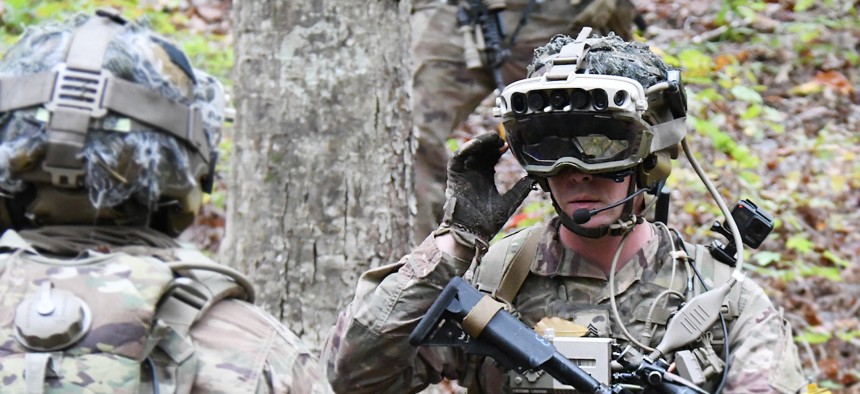
Soldiers from the 82nd Airborne Division use the latest prototype of the Integrated Visual Augmentation System during a trench clearing exercise in October at Fort Pickett, Va. U.S. Army / Bridgett Siter
US Army Ready to Roll Out Futuristic Goggles to Larger Force
Service to spend up to $22 billion on Microsoft-based IVAS augmented-reality headsets.
After two years of development, the U.S. Army’s augmented-reality headset is headed for the big time.
The service announced on Tuesday a contract with Microsoft worth as much as $21.88 billion over the next ten years. An Army statement said the award “transitions IVAS to production and rapid fielding to deliver next-generation night vision and situational awareness capabilities to the Close Combat Force.” That's at least 120,000 soldiers, AP reported. The contract is for ten years, with a five-year base and a five-year option.
The Army has been experimenting with the IVAS, a heads-up digital display based loosely on Microsoft’s HoloLens headset for gamers, for two years now, with some units sent to members of the special operations community. The headset connects to the cloud to offer what is often referred to as an “augmented reality” view. The goal is to allow soldiers to access any piece of data that might be useful to them in training, operations, or combat. That includes the view from a small aerial drone or a feed from cameras mounted on Army vehicles, visual targeting aids to differentiate friend from foe, and facial recognition, possibly even at night. Essentially, if the data can be gathered and sent, then it can appear in the headset.
Army leaders have not been shy about their high expectations for the IVAS and particularly how it will improve training, giving soldiers the ability to collect data on the missions they execute and then train and retrain on that data later. Lt. Gen. Scott McKean, the deputy commander at Army Future’s Command, speaking at a Defense One online event on Thursday, said that tools like IVAS would give soldiers a decisive advantage in future conflicts. “Before you even get to the battlefield being able to rehearse the 3D battlefield terrain that’s been developed is going to help our soldiers rehearse and do this before they even get on the battlefield and I think that will save lives,” he said.
“Impressed with the capabilities I saw today in the Integrated Visual Augmentation System (IVAS) prototype. Much like the smart phone transformed personal entertainment and how people connect, IVAS will transform how Soldiers prepare for and fight in combat,” Army Chief of Staff Gen. James McConville tweeted in October.
The IVAS program was also a test for the Army’s ability to match soldiers with researchers to better develop tools and software that soldiers will actually use, said McKean.
“This is really one of the key aspects of the Army’s modernization and what [Army Futures Command] is doing differently than what we [meaning the Army] did in the past and that’s the soldier touchpoints, having the soldier and the scientist team together so that not only is the soldier understanding how the technology is supposed to work but the scientist is understanding the context in which the soldier is going to use it and that’s where something like IVAS is going to really be a benefit moving forward because the soldier and the scientist have teamed together.” he said, “I think it’s going to increase the potential of these technologies that much faster. I think, moving forward, what we will see is our ability, our rate of innovation is going to increase because of that teaming.”
In a blog post, Microsoft said, “We appreciate the partnership with the U.S. Army, and are thankful for their continued trust in transitioning IVAS from rapid prototyping to rapid fielding. We look forward to building on this successful partnership with the men and women of the U.S. Army Close Combat Force.”




